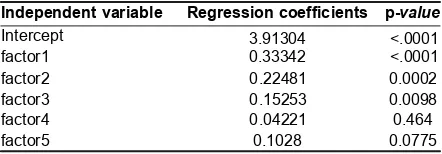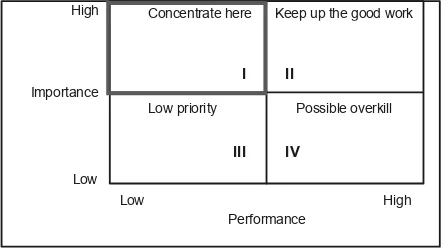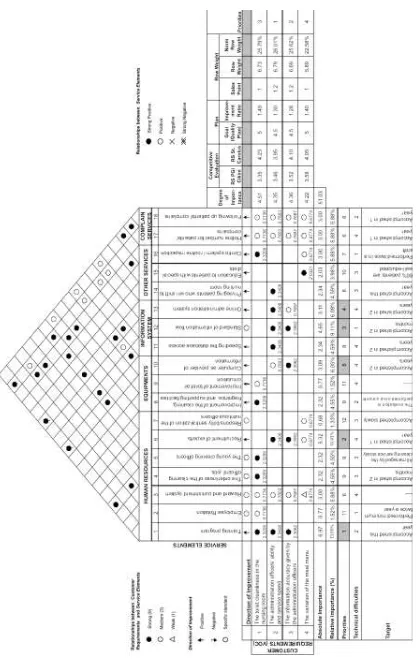Isti Surjandari, dkk.: Integrating Multivariate Method ...
INTEGRATING MULTIVARIATE METHOD AND QUALITY FUNCTION
DEPLOYMENT TO ANALYZE IN-PATIENT SATISFACTION
ANALISIS KEPUASAN PASIEN RAWAT INAP MENGGUNAKAN METODE MULTIVARIAT DAN QUALITY FUNCTION DEPLOYMENT
Isti Surjandari, Beatricia Pahlevi Thamarica
Industrial Engineering Department, Faculty of Engineering, University of Indonesia Kampus UI, Depok
ABSTRACT
Background : The increasing competition in healthcare industry has caused the delivery of service quality to patients become essential. Every hospital competes to deliver the best service to its patients. As a result, it is necessary to analyze hospitalized patient satisfaction. This study discusses service quality improvement in healthcare industry by analyzing in-patient satisfaction using Multivariate Analysis and Quality Function Deployment (QFD).
Objectives: The objectives of this study are to identify patients’ characteristics which are significantly affect their satisfaction level, to identify service attributes and dimensions which are critical to patients, and subsequently improve those attributes. Method: The identification of characteristics and service dimensions which are significantly affect patients’ satisfaction level is accomplished using Multivariate Analysis. While the critical service attributes identification is completed using Importance-Performance Analysis. Afterward, using House of Quality (HOQ), as the basis of QFD, those critical service attributes are developed into service elements.
Result: Using Discriminant Analysis, the result of this study shows that patients’ characteristics which significantly affect their satisfaction level are sex and occupation. The male and unemployed patients are more satisfied than the female and employed patients. Afterward, Factor Analysis brings about five new factors (service dimensions), which are the linear combinations of the original 42 service attributes. Based on the Importance-Performance Analysis, there are four service attributes which are critical to be improved which have high importance level, but low performance level. Then, using the Quality Function Deployment (QFD), the four critical service attributes are developed into service elements. The service elements with high priorities are training program, recruitment of experts, standard of information flow, online administration system, and computer as provider of information.
Conclusion: Service quality improvement in healthcare industry can be analyzed more comprehensive by integrating Multivariate Method and Quality Function Deployment (QFD). The result of this study may provide contributions to hospitals in general in enhancing its service performance to achieve its patients’ satisfaction.
Keywords: customer satisfaction, healthcare industry, multivariate analysis, quality function deployment
ABSTRAK
Latar belakang: Persaingan industri rumah sakit yang semakin kompetitif menyebabkan kualitas pelayanan menjadi penting. Setiap rumah sakit bersaing untuk dapat memberikan pelayanan
yang terbaik bagi pasiennya. Oleh karena itu, analisis mengenai kepuasan pasien rawat inap menjadi sangat penting. Fokus dari penelitian ini adalah peningkatan kualitas pelayanan di industri rumah sakit, yaitu dengan menganalisis kepuasaan pasien rawat inap menggunakan Analisis Multivariat dan Quality Function Deployment (QFD).
Objectives: Tujuan penelitian ini adalah untuk mengidentifikasi karakteristik pasien yang secara signifikan berpengaruh terhadap tingkat kepuasan, serta mengidentifikasi atribut dan dimensi yang diangap kritis oleh pasien dan perlu ditingkatkan. Hasil: Hasil Analisis Diskriminan menunjukkan bahwa karakteristik pasien yang signifikan berpengaruh terhadap kepuasan pasien adalah jenis kelamin dan pekerjaan, dimana pasien laki-laki yang tidak bekerja merasa lebih puas daripada pasien wanita yang bekerja. Kemudian Analisis Faktor menghasilkan lima faktor (dimensi pelayanan) yang merupakan kombinasi linear dari 42 atribut pelayanan. Berdasarkan
Importance-Performance Analysis, terdapat empat atribut pelayanan yang perlu ditingkatkan karena memiliki tingkat kepentingan tinggi dengan performansi yang rendah. Keempat atribut tersebut adalah: program pelatihan, rekrutmen ahli, standarisasi aliran informasi, sistem administrasi online, dan komputer sebagai penyedia informasi. Keempat atribut tersebut dikembangkan menjadi elemen pelayanan dengan menggunakan QFD.
Kata kunci: kepuasan pelanggan, rumah sakit, analisis multivariat, quality function deployment
INTRODUCTION
The increasing competition in every industry has been occured along with the growth of the nations. Each company and industry competes to deliver the best product and service to gain the market share. Customers are benefited most from this situation. Various of choices are available, so that customers are able to pick out the product or service which suits them most. Mostly, this condition is happened to the mass products or services which are yielded by lots of producers.
The same condition is happened to the healthcare industry. The wide market segment and the high needs of customers, who in this case are patients, to attain satisfaction have caused the increasing competition. The perfect competition market is occurred in healthcare industry.
VOLUME 12 No. 02 Juni l 2009 Halaman 68 - 73
Consequently, the delivery of service quality to patients becomes essential and the challenge to increase patients’ satisfaction becomes profound.
Definitely, customer satisfaction is the result of customer’s evaluation concerning quality of a product or service. Customer satisfaction is also defined as an emotional response of evaluation to consumption experience of a product or service. The achievement of customer satisfaction is the potent weapon to move in the competition, gain the competitive advantage, and broaden the market share.1 Customers will be
loyal if the product or service delivered satisfies more than competitors.
Besides maintaining customers, the benefits coming from contributing satisfaction to customers are more customers’ consumption, more stories to tell about our product or service to other people, less concern about competitors’ promotions, also less price sensitivity. To achieve the customer satisfaction, the management commitment and the right knowledge about customers’ needs and perceptions are necessary.2
The main issue that will be discussed in this study is to analyze hospitalized patient satisfaction. For the purpose of this study, PGI Cikini Hospital, as one of the well-known private hospitals in Jakarta, will be used as a case study. Hospitalized patient satisfaction will be analyzed using multivariate analysis and House of Quality (HOQ). Ultimately, the objective of this study are: (1) to identify patients’ characteristics which are significantly affect their satisfaction level, (2) to identify service attributes and dimensions which are actually critical to patients, (3) to improve the critical service attributes based on voice of customer.
METHODS
The data collection was conducted by questionnaire. The information acquired by the questionnaire were the patients’ characteristics, the patients’ satisfaction level and importance level of each service attribute in PGI Cikini Hospital, and the patients’ satisfaction level of overall service delivered. Patients’ characteristics asked it the questionnaire consists of 12 characteristics, which contained of personal (demographic) characteristics and characteristics related to patients’ experiences in PGI Cikini Hospital. The service attributes, which were asked in the questionnaires, are consisted of 42 attributes. These patients’ characteristics and service attributes selection was performed based on study held in other hospitals, the opinion of several medical practitioners at PGI Cikini Hospital and
another hospital, also several ideas, which were finally approved by PGI Cikini Hospital.
Multivariate analysis is the statistical method to process several measurements related to individual or several objects simultaneously.3
Numerous experts said that the purposes of multivariate analysis are to measure, explain, and predict the degree of relationship between variates. Where variate is a linear combination of variables which have weights, and the determination of which are conducted empirically. Multivariate analysis used in this study are Discriminant Analysis, Factor Analysis, and Multiple Regression Analysis.
Discriminant analysis is the statistical method to classify individual or object to two or more mutually exclusive groups based on several independent variables. Discriminant analysis is executed to accomplish the first objective of this study, which is to identify the patients’ characteristics that significantly affect their satisfaction level. Actually, there are two different groups, which are satisfied patients and very satisfied patients groups. The independent variables in this analysis are the twelve patients’ characteristics.
The second objective (i.e., is to identify service attributes and dimensions which are critical to patients) is accomplished using Factor Analysis, continued by Multiple Regression Analysis. Factor Analysis is a statistical procedure to understand lots of variables and objects, whether those variables have less number of groups, which groups are built based on similarity and correlation between them. Multiple Regression Analysis is a statistical method to show the relationship between two or more independent variables (predictors) and a dependent variable (criterion).4 With Factor Analysis, a lot of service
attributes can be simplified into several service dimensions. Then Multiple Regression Analysis can reveal weight of each service dimension to overall service performance, which is shown by the regression equation coefficient.
The satisfaction and importance level asked in the questionnaire used likert scale 1 to 5, where the interpretation of which is shown in the Table 1 below. Though there have been a controversy in practicing the likert scale, whether it is an interval or an ordinal scale, numerous marketing and psychology experts keep on using the likert scale as an interval scale, since not only they have certainly measured it in interval scale but also it have provided better results.5 Therefore, the mean of
Table 1. The Interpretation of Patients’ Opinion about Service Attributes
Table 2. Discriminant Analysis Result
Importance-Performance Analysis is performed to identify the service attributes critical to patients. Importance-Performance Analysis is a method to show performance and position of each service attribute. With this method, Importance-Performance Diagrams are built to show the performance level of each of the current service attribute versus the importance level, and illustrate service attributes needed to be developed.6
Quality Function Deployment (QFD) is a methodology to assure that customer requirements are addressed using the appropriate technical solutions.7 Quality Function Deployment (QFD) has
been used successfully in almost all industries, both in manufacturing and service industry. House of Quality (HOQ) is the first step in QFD process and the basis matrix of QFD. With HOQ, the critical service attributes, resulted from Importance-Performance Analysis, are developed into service elements. This step is carried out to achieve the third goal of this study, which is to develop the critical service attributes based on the voice of customer.
RESULT AND DISCUSSION
Questionnaires, which were used as data collection tool in this study, were spreaded out to 71 hospitalized patients in PGI Cikini Hospital which were taken care in the general nursing room, in aware condition, not hit by infected disease, and nurtured in the first class and the semi VIP class. 69 of 71 questionnaires were coming back and valid to be used for this study. Having gathered all of the information through the questionnaire and fulfilled the minimum sample requirements, reliability test, also validity test, then the data processing is carried out using Multivariate Analysis.
All of the data processing is performed using SAS 9.1. The following table shows the result of Discriminant Analysis.
! "
#$# #$# %
#$&%& & % #$&''%( & %
Discriminant Analysis shows that sex and occupation are significantly affect overal patients’ satisfaction level with 5% significance level. Sex has stronger discriminant power than occupation, with the discriminant score of 0.696. The recalculation of questionnaire data reveals that male and unemployed patients are more satisfied than female and employed patients.
To simplify the forty two (42) service attributes into several service dimensions, Factor Analysis is executed. Table 3 shows the result of Factor Analysis.
Table 3. Factor Analysis Result
)
* ) )
) ) ) () ') %) #) ) ) ) ) ) ) ) ) &) () + ) + ) + ) +
) ) ) ) ) ) ) &) +
, ) ) )
) ) ) )
- ) )
Factor Analysis bring about five new factors (service dimensions), which are the linear combination of the original 42 service attributes. This classification is performed based on the factor loading, which is the correlation coefficients between each attribute and each dimension.
Afterward, weight of each service dimension to overall service performance is shown by the regression equation coefficient from the Multiple Regression Analysis result below.
Table 4. Multiple Regression Analysis Result
$% # .$###
#$ .$###
#$ ' #$###
#$ #$##%'
#$# #$ & #$ # ' #$#((
dimensions are critical to patients. While factor4 (nutrition dimension) and factor5 (religious service dimension) are statistically not significant, and are considered weak to overall satisfaction level.
To understand the position of each service attributes and which attributes are critical to be developed, Importance-Performance Diagram for each service dimensions is constructed. The X-axis and Y-axis show the mean of satisfaction level (performance) and importance level of all of the service attributes in the diagram. Accordingly, there are four quadrants in the diagram, as shown in the figure below.
attributes in PGI Cikini Hospital are lower than St. Carolus Hospital.
3. Goal, that is the ultimate objective of patients’ satisfaction the PGI Cikini Hospital intends to achieve.
4. Improvement ratio, that is the ratio between the goal and the actual performance.
5. Sales point, that is given to the service attributes which has high sales power. The attributes with high sales power scores (1.5), medium scores (1.2), and does not have sales power scores (1).
6. Row weight, that is weight of each service attribute to determine priorities, calculated by multiplying degree of importance, improvement ratio, and sales point.
7. Normalized row weight, that is the row weight proportion to the total row weight.
8. Priorities, that is the sequence of importance to customer requirements fulfillment based on the row weight.
After that, the cause and effect analysis is performed to find out the appropriate service elements for each customer requirement. The next step is gathering the following information:
1. Direction of improvement, that is the direction of service element the customers wants, whether positive, negative, or specific standard. 2. Target, that is the goal of service element. 3. Technical difficulties, that is the degree of
difficultness to succeed the service element. 4. Relationship matrix, that is the relationship
between customer requirements and service elements. The strong relationship scores 9, medium scores 3, and weak scores 1.
5. Correlation matrix, that is the relationship between service elements. The relationship might be strong positive, positive, negative, or strong negative. The correlation matrix showing the positive and strong positive relationship means PGI Cikini Hospital can develop all of the service elements without any other service elements which will be disturbed.
6. Absolute importance, that is weight of each service element to determine priorities, calculated by the following equation:
7. Relative importance, that is the absolute importance proportion to the total absolute importance.
8. Priorities, that is the sequence of importance to service elements fulfillment based on the absolute importance.
/ + 0 + 1 2
3 1 4 2
!
3 1
3 1 5 +
4 5 +
Figure 1. Importance-Performance Diagram
The service attributes which are critical to be improved are the ones shown in the first quadrant (concentrate here). They are the ones which have high importance level, but low performance level. Those service attributes are:
1. The toilet cleanliness in the nursing room – b7 2. The administration officers’ ability and service
speed – c2
3. The information accuracy given by the administration officers – c3
4. The variation of the meal menu – f5
Then those four service attributes become customer requirements (voice of customer), which will be developed through the HOQ. Figure 2 shows the HOQ as the development of those four customer requirements at PGI Cikini Hospital.
The next step after knowing the customer requirements is gathering the following information: 1. Degree of importance, that is resulted from the
survey.
CONCLUSIONS
Using Discriminant Analysis, the result of this study shows that patients’ characteristics which significantly affect their satisfaction level are sex and occupation. The male and unemployed patients are more satisfied than the female and employed patients.
Afterward, Factor Analysis brings about five new factors (service dimensions), which are the linear combinations of the original 42 service attributes. The five factors are: (1) nursing room, administration, nurses, and supporting facilities dimension, (2) general facilities and comfort dimension, (3) doctors dimension, (4) nutrition dimension, and (5) religious service dimension. Based on Regression Analysis, from those five factors, only the first three factors are statistically significant and critical to patients.
Then using the Importance-Performance Analysis, this study found that there are four service attributes which are critical to be improved that have high importance level, but low performance level. These four attributes are: (1) the toilet cleanliness in the nursing room, (2) the administration officers’ ability and service speed, (3) the information accuracy given by the administration officers, and (4) the variation of the meal menu.
Hence using the HOQ, the four critical service attributes are developed into service elements. The service elements with high priorities are training program, recruitment of experts, standard of information flow, online administration system, and computer as provider of information.
By integrating Multivariate Method and QFD, this study offer a more comprehensive result in analyzing
hospitalized patient satisfaction, and may provide contributions to hospitals in general in enhancing its service performance to achieve its patients’ satisfaction.
REFERENCES
1. Wang, Yonggui and Hing-Po Lo, “Service Quality, Customer Satisfaction, and Customer behavior Intentions”, Evidence from China’s Telecommunication Industry, Info, 2002;4(6): 50-60.
2. O’Neill, Martin A., et al., “Diving Into Service Quality-The Dive Tour Operator Service” Managing Service Quality, 2000; 10(3);131-40. 3. Hair Jr., Joseph F., et al., Multivariate Data Analysis, Fifth Edition, Prentice-Hall International, Inc., New York, 1998.
4. Dillon, William R. and Matthew Goldstein, Multivariate Analysis: Methods and Applications, John Wiley and Sons, Inc., Canada, 1984.
5. Churchill Jr., Gilbert A., Basic Marketing Research, Third Edition, the Dryden Press. Orlando, 1996.
6. Ford, John B., et al., “Importance-Performance Analysis as a Strategic Tool for Service Marketers: The Case of Service Quality Perceptions of Business Students in New Zealand and the USA”, the Journal of Services Marketing, 1999; 13(2);171-80.
F
ig
u
re
H
o
u
s
e
o
f
Q
u
a
li
ty
(H
O
Q
)
o
f
th
e
F
o
u
r
C
u
s
to
m
e
r
R
e
q
u
ir
e
m
e
n
ts
a
t
PG
I
C
ik
in
i
H
o
s
p
ita


